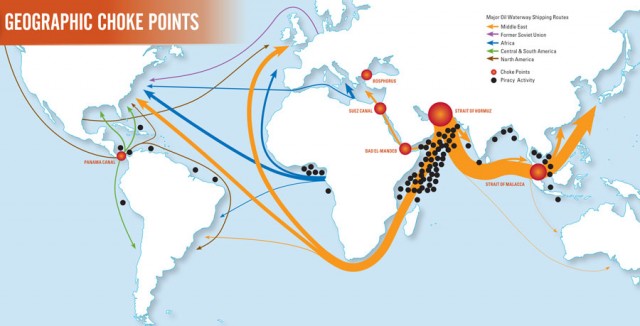choke point
A CHOKE POINT IS ANY narrow passage that restricts traffic. It literally connotes a location where the flow could be choked off. As a military term, it refers to areas in lines of sea, ground, air or space communications (physical travel) that restrict freedom of movement by slowing and confining. This allows an adversary to focus observation, targeting, and engagement assets on a likely area of contact, which can occur at several scales both conceptually and physically at the choke point.
At the tactical level of operations, the spectrum of choke points may array from a doorway of a building, to a bridge across an impassable river, to a mountain pass of some width. As the level of operations expands, then major ports and river valleys add to the array. Globally, major straits, isthmuses, and coastal corridors may “choke” movement of men and materiel at that larger scale of operation.

Maritime strategists have used the concept of controlling choke points as a resource-efficient way to negate the near total maneuverability availed by the open ocean. Transit from world waterway to world waterway is often confined by constricted terrain, be it submerged or above sea level. The BAB EL MANDEB, Straits of Hormuz, Malacca Straits, Cape of Good Hope, Greenland–Iceland-United Kingdom (GIUK) Gap, the Straits of GIBRALTAR, and the English Channel are a short list of the many challenges to any battleship captain. Sir John Fisher, First Sea Lord of the Royal Navy may have coined the phrase “choke point.” He proposed that the control of these key locations was central to the domination of the seas and consequently to the welfare of the UNITED KINGDOM.
Commercial concerns arise where natural hazards or accidents could disrupt the flow of goods, particularly oil. Oil transport by tanker is the most flexible means of transport on a global scale. Restricted to a near fixed set of maritime routes because of economic efficiencies, the tankers are vulnerable to a number of choke points. An accident in one of these restrictive passages could cause immediate disruption of commerce and significant financial loss. Be they natural (Strait of Hormuz) or man-made (Suez Canal), they pose a significant risk. However the economic effects must not be overstated in every case. The closure of the Suez Canal from late 1960 until 1975 caused the marketplace to adapt, and the advent of the supertankers brought new economic efficiency along with ecological perils.
Military and commercial operations are now dependent upon space-based assets such as navigational, meteorological, and communications satellites. The concept of choke points is equally applicable to space. Launch restrictions based on Earth rotation, orbit targets, and cargo requirements place spacecraft into a very restricted launch “tunnel” that extends from the fixed site launch facility to its orbital target. Spacebased or terrestrial-based military assets could focus on this tunnel for observation and interdiction. Certain points in translunar space, known as lunar libration points, provide physical advantages of a military nachokture. Basically objects at these locations enjoy a balance of lunar and earth gravitational pulls and can hold position effectively with low fuel consumption. These positions can contest access to and from the moon while dominating earth and moon by observation. They may constitute operational chokepoints.
The term choke point has gained wider usage to include any constraining aspect of an operation or process, be it military, business, or academic. It is now being applied to cyberspace when addressing network security and vulnerability.